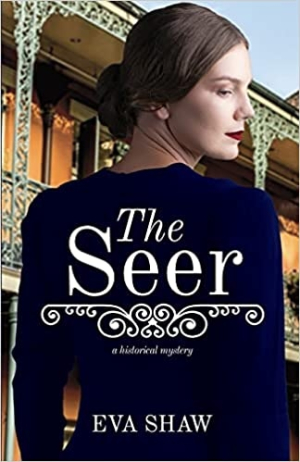The Seer
In the historical mystery novel The Seer, a woman who makes her living selling lies faces the truth about her past.
In Eva Shaw’s historical mystery novel The Seer, a cunning young psychic is asked to use her abilities to uncover the truth—but the one mystery that she desperately wants to unravel, the mystery of her past, eludes her.
It’s 1942, and World War II grips New Orleans, casting fear over the city. Hatred against Asian people runs in the hearts of the city’s citizens, making New Orleans a dangerous place for Chinese scientist Thomas Ling. But for Beatrix, a psychic prone to phony readings, war means good business. Distraught and desperate citizens seek news about the future through her.
Even the United States Army has caught wind of Beatrix’s abilities. They hire her to expose the Nazis hiding in New Orleans. Knowing her only real gift is being a good liar, Beatrix recruits mild-mannered Thomas to help her in the investigation, and to act as her bodyguard as she encroaches on dangerous information. As the pair dig toward the truth, they uncover government secrets that could change the outcome of the war, and secrets about Beatrix’s past that could change her fate.
As Beatrix navigates the French Quarter, drinks coffee at Cafe du Monde, and walks along the Mississippi River, the setting is set in lush detail. Precise, descriptive imagery works to create visuals of the city. But this is not a lively New Orleans: somber images punctuate the plot, as of blacked-out windows. There’s a running thread concerning canceled Mardi Gras festivities, too, showing how the war has burdened the city.
Beatrix and Thomas are less distinctive than the setting, though. They are characterized most in terms of their lines of work, and there are some cliches in this: Thomas is a reasonable scientist, and Beatrix is a snappy conwoman. Neither step far beyond their roles, and their motivations for working together are hazy. They have little to gain from each other’s presence, and Thomas often expresses the desire to get away from dangerous, intimidating Beatrix. Their romantic attraction is squeezed into the book’s ending, but feels unnecessary.
The novel’s pacing is controlled; it ebbs and flows in accordance with the amount of action taking place. In times of high action, as during the climax, the narrative is quick and urgent; in times of low action, it slows, allowing for absorption of facts. And clues are shared throughout the text, providing enough information to guess at the culprits without spoiling the fun of the mystery. The novel ends with a sense of satisfaction and resolution, with the remaining questions answered and the several mysteries that Beatrix and Thomas confronted unraveled.
In the historical mystery novel The Seer, a woman who makes her living selling lies faces the truth about her past while trying to keep a war from ravaging her beloved city.
Reviewed by
Melissa Lance
Disclosure: This article is not an endorsement, but a review. The publisher of this book provided free copies of the book and paid a small fee to have their book reviewed by a professional reviewer. Foreword Reviews and Clarion Reviews make no guarantee that the publisher will receive a positive review. Foreword Magazine, Inc. is disclosing this in accordance with the Federal Trade Commission’s 16 CFR, Part 255.

